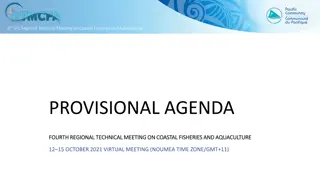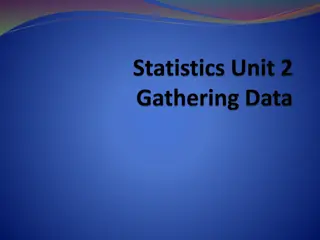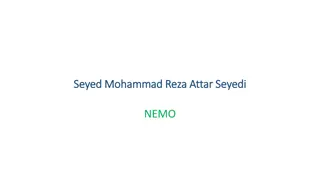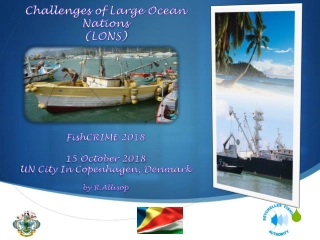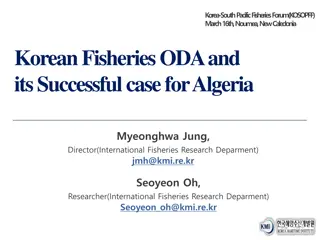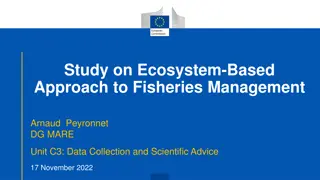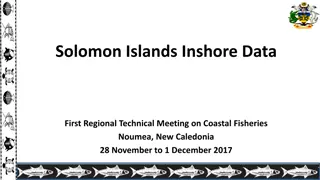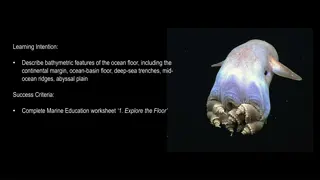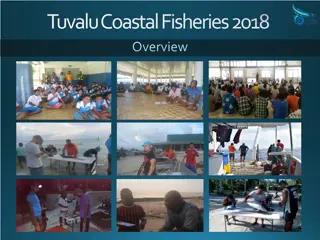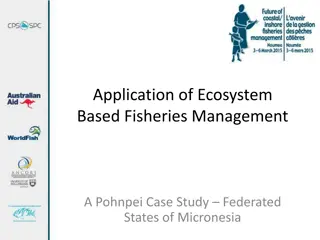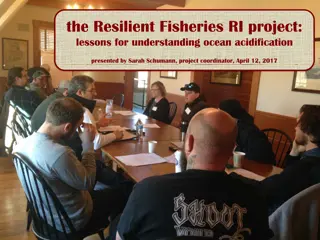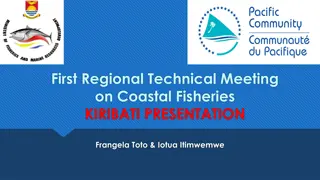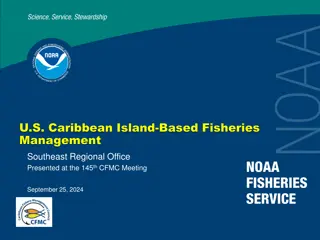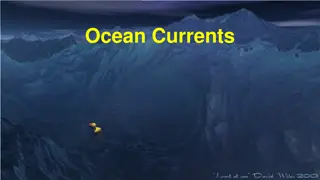Fisheries Management and Observational Requirements for Ocean-Related Variables
This content provides insights into observational requirements for ocean-related variables concerning fisheries, focusing on marine fish production in CRFM countries, the Flyingfish Management Plan, Caribbean Spiny Lobster management, and other fisheries management plans. It discusses the main objectives of fisheries management and emphasizes achieving optimum exploitation levels for sustainable fisheries.
- Fisheries Management
- Ocean Variables
- Marine Fish Production
- Sustainable Fisheries
- Observational Requirements
Download Presentation

Please find below an Image/Link to download the presentation.
The content on the website is provided AS IS for your information and personal use only. It may not be sold, licensed, or shared on other websites without obtaining consent from the author. Download presentation by click this link. If you encounter any issues during the download, it is possible that the publisher has removed the file from their server.
E N D
Presentation Transcript
Session 4: Observational requirements for ocean-related variables related to fisheries Milton Haughton Executive Director
Marine Fish Production CRFM Countries (MT) 160000 155000 150000 145000 140000 135000 130000 125000 120000 115000 2003 2004 2005 2006 2007 2008 2009 2010 2011 2012 2013 2014 2015 Years
Flyingfish Management Plan Very Important small pelagic fishery Stable fisheries not overfished but many challenges for long-term 7 States (Barbados, Trinidad, St. Lucia, Dominica, Grenada, St. Vincent/ Grenadines, Martinique) FMP developed over several years Adopted 2014 by CRFM Council FMP implemented by States 1streview of implementation (2016) CLME+ Project funding supporting implementation e.g evidence-base, catch documentation & traceability
Management of Caribbean Spiny Lobster Most important commercial species highly traded, IUU fishing St. Georges Declaration on Conservation, Management and Sustainable Use of the Caribbean Spiny Lobster (P. argus) Joint WECAFC/CRFM/OSPESCA Regional Lobster FMP Joint Lobster Working Group Other Caribbean States CRFM States
Other Fisheries Management Plans and Instruments Joint Regional Queen Conch Fisheries Management Plan FAD Fisheries Management Plan (Draft) Blackfin Tuna Fisheries Management Plan (Draft)
What is the main objective of fisheries Management? Achieve optimum exploitation level for the stock UNCLOS, FSA, SDG speak of MSY What is Maximum Sustainable yield? The highest theoretical equilibrium yield that can be continuously taken (on average) from a stock under existing (average) environmental conditions without affecting significantly the reproduction process (FAO)
Fisheries Management & Stock Status To conduct stock assessment Scientific analysis of the abundance & composition Use best information available, data from fishery landings, independent scientific surveys & biological data Output of Stock assessment: Determine stock status (overfished, approaching overfishing, under-exploited, rebuilding etc) Recommend annual catch limits & management or conservation measures that may be required Assess effects of conservation & management measures
What is needed for stock assessment? Catch & Effort Data amount of fish removed from a stock by fishing effort spent to get the catch (nos. traps, boats, hooks used, hours spent fishing etc) Data collection programme: A network of fishery data collectors that continuously collects catch & effort data for stock assessment Sources of catch data include: Monitoring at landing site (docks, ports or beaches) - commercial landings and biological samples of the length, sex, and age of fish. Logbooks: commercial fishermen - location, gear, and catch. Observers: Biologists on fishing boats observe fishing operations & collect data on the amount of catch and discards. Recreational sampling: interview surveys and dockside sampling estimate the level of catch by the recreational fishery
What is needed for stock assessment? Independent Survey Measure abundance or relative index, of the number or weight of fish in the stock Data collected by a statistically-designed, fishery- independent survey by research vessel that samples fish throughout the stock s range. Dive survey Ideally Surveys should be conducted annually at same time Biology Data Provides information on fish growth rates & natural mortality Information on fish size, age, reproductive rates, movement Collected at landing site, during survey or academic A LOT OF DATA????? = Money & Capacity??? For classical stock assessment
Indicator 14.2.1-Proportion of national exclusive zones managed using ecosystem-based approaches. Percentage of stocks with ecosystem based-fisheries management plans Oceanographic Primary production Ocean currents Ocean temperatures Ocean oxygen Salinity Acidity (pH) Nutrients turbidity Socioeconomics of fishers Education levels of fishers Fisher income Fixed and operational costs of fishing
Indicator 14.2.1-Proportion of national exclusive zones managed using ecosystem-based approaches. Percentage of stocks with ecosystem based-fisheries management plans Catch and effort data for target species By-catch data Habitat information- e.g. habitat type, coverage & health critical fish habitats Food webs - Predator prey relationships Both the number of species and the distribution of biomass distributed among species
Indicator 14.4.1-Proportion of fish stocks within biologically sustainable levels Percentage of countries with national data collection systems Number of stock assessments conducted Stock statuses known for commercially important species Proportion of fish stocks within biologically sustainable limits Need to understand population dynamics of stocks [Entry of young fish, growth, mortality, migration] Recruitment Size composition - Length-weight Maturity (rates and weight at age in stock) Growth functions Fecundity Mortality- fishing and natural Biomass at age Harvest parameters (gear selectivity, catchability)
What challenges do SIDs face in assessing stocks? Tropical fisheries multi-gear, multi-species = complex Data poor for many stocks data collection & assessment tend to focus on more commercially important stocks Conventional stock assessment methods, such as the age- based methods, are data-intensive, single species model: not very suitable for tropical stocks Length-based methods, which have been developed & promoted for tropical stocks, not very accurate Limited, therefore, to use of surplus production models, which are usually single-species models, but applied to fisheries that are often multi-gear operations, multiple species Hence, more sensible for countries with such fisheries to work with simpler markers of stock health, that could cover several species at a time ecosystems approach. High cost of data collection & surveys, & limited human & institutional resources
What challenges do SIDS face in assessing stocks? While having long-term, continuous datasets for each species is ultimate goal, data-poor methods can still provide useful information & reduce risks associated with fishing in ignorance CRFM states use conventional methods when appropriate and data available Otherwise, we use trends in catch & size composition & local knowledge to determine stock status Indirect indicators that suggest overfishing include: A reduction in the stock biomass; Catches exceed their target reference points; Change in the size and age composition, reduction in larger size class and mature individuals declining catch or value per unit effort [Decline may be due to management intervention]
What challenges do SIDS face in assessing stocks & Fisheries Management? Additional issues Experience with CRFM Scientific Meetings Compatibility of data for regional assessments Sharing of data & information Capacity challenges reliance on external experts Next Steps Norwegian Research Vessel (RV) Dr. Fridtjof Nansen Fisheries information technology innovations for resource management and climate change adaptation in the Caribbean (FIT4CC),
THANK YOU THANK YOU www.youtube.com/TheCRFM www.facebook.com/CarFisheries www.twitter.com/CaribFisheries



